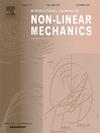Modelling the finite deformation of thermoplastic polymers via hyperinelasticity, Part II: An amorphous polymer with varying rubber content-, rate- and temperature-dependency
IF 2.8
3区 工程技术
Q2 MECHANICS
International Journal of Non-Linear Mechanics
Pub Date : 2025-06-27
DOI:10.1016/j.ijnonlinmec.2025.105182
引用次数: 0
Abstract
In Part I we presented the application of the hyperinelasticity modelling approach to the large elastic and inelastic deformations of semi-crystalline polymers. In this sequel we extend the application of this model to the finite strains of amorphous polymers, by studying Poly(methyl methacrylate), i.e., PMMA, and rubber-toughened PMMA (RT-PMMA) polymer systems. The effects of variation in rubber particle content, temperature and deformation rate on the elastic and inelastic mechanical behaviour of the specimens will be examined and modelled, under large uniaxial compression. The core model will be calibrated using base-line behaviours (i.e., quasi-static deformation, zero particle content, ambient temperature etc.), and the augmented model will be shown to favourably capture the effects of the foregoing inelasticity-inducing factors on the deformation behaviour of the samples. The augmentation of the core model is achieved by considering a linear evolution of the core model parameters, as the function of, e.g., particle content, deformation rate, temperature etc. Predictions of the elastic and inelastic behaviours at intermediary values of temperature/rubber content etc will also be made, and will be verified against experimental data to demonstrate the close match between the two. Given the success of the modelling approach in these applications and in Part I, this two-part contribution concludes a unified modelling tool for application across various thermoplastic polymers, from semi-crystalline to amorphous polymer types. Such a model allows exploration and prediction of the shift in the material response of semi-crystalline polymers from a thermoplastic-like to a rubber-like behaviour, and the reshaping of the amorphous matrix response in the presence of inelasticity-inducing effects for amorphous polymers, using a unified modelling approach.
模拟热塑性聚合物的有限变形通过超弹性,第二部分:一个无定形聚合物与不同的橡胶含量,速率和温度依赖性
在第一部分中,我们介绍了超非弹性建模方法在半结晶聚合物大弹性和非弹性变形中的应用。在这个续集中,我们通过研究聚(甲基丙烯酸甲酯),即PMMA和橡胶增韧PMMA (RT-PMMA)聚合物体系,将该模型的应用扩展到非晶聚合物的有限应变。在大单轴压缩下,橡胶颗粒含量、温度和变形率对试样弹性和非弹性力学行为的影响将被检查和建模。核心模型将使用基线行为(即准静态变形,零颗粒含量,环境温度等)进行校准,并且增强模型将被证明能够很好地捕获上述非弹性诱导因素对样品变形行为的影响。核心模型的增强是通过考虑核心模型参数的线性演变来实现的,如颗粒含量、变形速率、温度等的函数。还将对温度/橡胶含量等中间值下的弹性和非弹性行为进行预测,并将通过实验数据进行验证,以证明两者之间的密切匹配。鉴于建模方法在这些应用和第一部分中的成功,这两部分的贡献总结了一个统一的建模工具,适用于各种热塑性聚合物,从半晶到非晶聚合物类型。这样的模型允许探索和预测半结晶聚合物的材料响应从类似热塑性塑料到类似橡胶的行为的转变,以及在非晶态聚合物的非弹性诱导效应存在下非晶态矩阵响应的重塑,使用统一的建模方法。
本文章由计算机程序翻译,如有差异,请以英文原文为准。
求助全文
约1分钟内获得全文
求助全文
来源期刊
CiteScore
5.50
自引率
9.40%
发文量
192
审稿时长
67 days
期刊介绍:
The International Journal of Non-Linear Mechanics provides a specific medium for dissemination of high-quality research results in the various areas of theoretical, applied, and experimental mechanics of solids, fluids, structures, and systems where the phenomena are inherently non-linear.
The journal brings together original results in non-linear problems in elasticity, plasticity, dynamics, vibrations, wave-propagation, rheology, fluid-structure interaction systems, stability, biomechanics, micro- and nano-structures, materials, metamaterials, and in other diverse areas.
Papers may be analytical, computational or experimental in nature. Treatments of non-linear differential equations wherein solutions and properties of solutions are emphasized but physical aspects are not adequately relevant, will not be considered for possible publication. Both deterministic and stochastic approaches are fostered. Contributions pertaining to both established and emerging fields are encouraged.

 求助内容:
求助内容: 应助结果提醒方式:
应助结果提醒方式:


